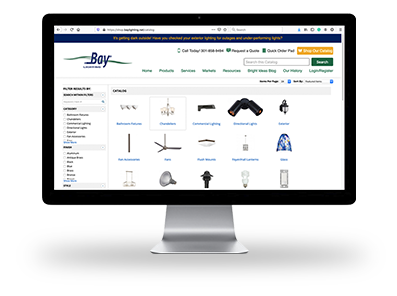Blog
- Home
- Resources
- Bright Ideas Blog
- Considerations for Creating a New Indoor Lighting Plan for Your Commercial Space
Considerations for Creating a New Indoor Lighting Plan for Your Commercial Space
Whether you are renovating your entire facility or retrofitting your existing fixtures, making a commercial lighting plan is an essential first step. There are a multitude of factors to consider, and there is no one-size-fits-all plan. Every individual space is different, and organizations have varying lighting needs. Improper lighting can even be a hazard to employees or customers, so making a plan to cover all of your bases can only increase your chances of having a fast, cost-effective, efficient installation process.
Assess your needs
When making any kind of plan, a good first step is to take a look at your specific needs and goals. How large is your space? Which parts of the interior of your building need more illumination than others? Are there areas that have decreased access to natural light? Think about the lighting levels your employees or customers need in order to function safely inside your space. A new indoor lighting plan is also a great opportunity to prioritize your goals. Perhaps lowering your carbon emissions or saving money on your electric bill are important to you. Factors such as these need to be considered before an indoor lighting plan can be developed.
LED fixtures
There are countless benefits to choosing LED fixtures for your commercial space. LED technology is on the forefront of lighting innovation for its energy-saving and safety benefits and its quality of light. A business operating on a budget can benefit tremendously from the savings associated with LED fixtures, considering their average lifespans of 20,000 to 50,000 hours and low amount of energy required to power them. Most commercial spaces require a lot of lighting, and installing LEDs can help lower your electric bill and decrease your carbon footprint.
There are many different LED fixtures available that can serve your particular needs, whether your space is a large warehouse or a small office. Some common commercial LED light fixtures include:
- Suspended – Suspended LED lighting fixtures are hung or mounted directly to the ceiling to clearly illuminate the space below. They are a popular choice for indoor commercial applications for their diffused, gentle light that is not too bright and harsh, but still clear. The lighting quality of suspended LEDs is high, with strong color rendering, color temperature, and lumen output. They utilize different types of lenses to properly distribute the light upward, downward, or both ways.
- Recessed – Recessed LEDs are installed in openings in the ceiling in order to cast direct light on the space below. These fixtures have replaced CFL tubes due to their increased efficiency, ease of maintenance, and how easily their housing can be hidden from view. These are a great choice for those looking for low heat emission and a discreet but powerful light source.
- Surface – Surface LED fixtures are similar to recessed fixtures, the main difference being that they are mounted onto the surface of a wall or ceiling instead of housed within it. They are cost-efficient and low-power, and are a great choice for more compact designs or spaces. They come in a variety of color and lens options, and are especially durable and shock-resistant.
- Modular –Modular fixtures can be broken down into smaller parts and can be integrated into different systems or created individually. A modular LED fixture is a cost-effective and efficient choice for a commercial space. Benefits include optic control, heat dissipation, and incremental lumen output.
- Strip – Strip lights can be used in commercial spaces for a cleaner, more discreet aesthetic appearance. They are flexible and can be bent up to 90 degrees or vertically, allowing for illumination in difficult spaces. Strip LEDs can be made to emit a variety of single colors or outfitted with color changing options. They are often used in accent lighting, shelving and office spaces, storefront displays, handrails and walkways, and product display areas.
Consider accessibility
As an owner or manager of a commercial space, it is critical that you consider safety and functionality People need to be able to see clearly when they are working. The last thing an owner wants is for an employee or customer to injure themselves due to improper lighting levels. Beyond this, people need to be able to see their work, products being sold, and each other clearly in a public space. For these reasons, it is critical to work with a lighting expert to determine your needs and the proper lighting to ensure your employees and/or customers are safe and can conduct their business at optimal levels.
Choose the right color
Color is an important consideration when it comes to lighting your commercial space. Commercial lighting with high-quality color temperature and color rendition can actually increase productivity and affect the environment of your space greatly. These requirements generally vary from one type of business to another, so it is best to consult with a lighting technician to determine your specific needs. For example, a retail store might need softer lighting to create a comfortable, welcoming environment that highlights the products, whereas a warehouse requires bright illumination for a safe workspace.
It is almost important to choose a bulb that has the right lumens. This affects brightness and dimness and your desired light levels. For example, a 100-watt incandescent bulb gives off 1,600 lumens. If a light is too bright, it can cause headaches and eyestrain. If it’s too dark, it can affect productivity and create a gloomy or dull environment.
Lumen output
Lumen, or the measurement unit of the quantity of visible light produced by a lightbulb, expresses the performance of a light source. Overall, the brighter the light, the higher its lumen rating. Installed in cold applications, studies have shown that LED degradation reduces and lumen output improves. Modern LEDs are outfitted with special features that prevent any heat-related lumen depreciation, such as heat sinks that channel excess electrical heat and keep it away from the driver and the LED itself.
Fluorescent and incandescent bulbs are measured in watts, which measures power usage rather than brightness. Due to their higher efficiency, LED lights output the same amount of light as a halogen lamp with half the amount of energy. For example, an LED that is using 6.5W will produce the same amount of light as a 50W fluorescent light source. LED light output and efficacy (lumens per watt) increases as the temperature drops, making them the best choice for outdoor applications.
In conclusion
When it comes to selecting lighting for your interior commercial space, planning and consulting with an expert is key. No two buildings are exactly alike, and lighting needs vary greatly depending on factors like business type, energy consumption goals, and safety requirements. Fortunately, there is an array of products available that can be worked into a plan that fits your organization’s needs perfectly. There are a lot of factors to consider when planning a lighting scheme, so it’s best to reach out to a professional who can evaluate your space and plan an installation that stays within budget and is minimally disruptive to your daily life. Work with a local lighting distributor to make a plan for your commercial space.
Contact us
If you are looking to begin a new interior lighting plan for your commercial space, contact Bay Lighting today. We work with Maryland, DC, and Virginia businesses to plan, install, and maintain state-of-the-art lighting schemes that use the most cost-effective and energy-saving products available. We offer a variety of lighting services in order to continue to keep your light fixtures in the best shape possible even after installation.




